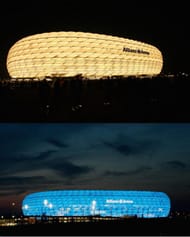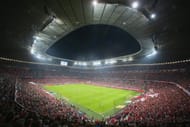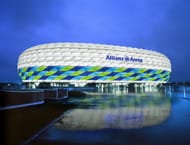The story of the majestic Allianz Arena Stadium leads inevitably to the history of its affluent owners, Bayern Munich, an institution which has stood the test of time and cemented its status as the pride of Germany. Some truly magnificent players such as Manuel Neuer, Franck Ribéry, Robert Lewandowski, Arjen Robben and Philipp Lahm have graced the Allianz Arena’s sacred turf in the famous all-red strip in recent times.
The stadium has also hosted many memorable international matches, most notably the 2006 FIFA World Cup semi-final between Portugal and France, which the Les Blues won 1-0 to advance to the finals where they met eventual winners Italy at the Olympiastadion.
Built on the northern edge of Munich's Schwabing-Freimann borough on the Fröttmaning Heath, the stadium is the third largest arena in Germany behind Signal Iduna Park in Dortmund and the Olympiastadion in Berlin.
Design of the Stadium
Designed by architects Herzog & de Meuron, the stadium’s main entrance is in the form of an elevated esplanade with 2,760 diamond-shaped cushions forming the world’s biggest membrane cladding covering an area of 66,500 m².
Herzog & de Meuron envisioned the stadium as an illuminated body in an open landscape that can change its appearance, and that led them to develop the concept of the see-through exterior made of ETFE-foil panels, which can be lit from the inside and are self-cleaning.
Nicknamed as the "Schlauchboot" or “inflatable boat”, the stadium is illuminated red at night for Bayern’s home matches and presents a breath-taking sight when viewed from above.
TSV 1860 München and the German National Team are also tenants of the stadium of which Bayern are the sole owners.
The Allianz Arena is lit in blue when 1860 Munich host their home matches, and in white when the German national team play on the turf. The three-tier interior of the Allianz Arena has extraordinary acoustics that rapidly turn the stadium into a cauldron when hosting exhilarating encounters and the roof of the stadium is equipped with built-in roller blinds which can be drawn back and forth during games to provide protection from the sun.
The name of the Arena is the name of its sponsor, the Allianz insurance company who donated €110 million to have their logo and name associated with one of the most attractive stadiums in the world.
It is nearly always occupied to its full capacity with two million fans visiting the stadium over the course of the year. Each season, the 75,000 available seats and standing places are sold out for all 17 of Bayern’s Bundesliga home games.
The stadium was designed keeping the supporters in mind and it should come as no surprise that the fans expect to be well looked after, both before and after the game. Hence, the club has installed 6,000 m² of catering facilities to take care of culinary whims of its silverware-hungry supporters.
The Schlauchboot also houses Europe’s biggest multi-storey car park which has provisions for nearly 10,000 parking spaces.
May 2012 saw the installation of the FCB Erlebniswelt at the Arena thus giving the fans another reason to flock to the stadium. The Erlebniswelt is Germany’s biggest club museum and recounts the glorious history of Bayern Munich in an interactive installation covering more than 3,000 m².
Historic Games
The Arena was packed to the rafters for its inaugural game as TSV 1860 München played an exhibition game against FC Nürnberg on 30th May 2005. The very next day, a packed stadium played host to a friendly between the German National team and Bayern Munich (4-2).
Just over a year later, it was the stage for Germany’s dramatic 4-2 victory over Costa Rica in the first match of the FIFA 2006 World Cup tournament, where Klose scored a brace to ensure the final score line read in the favour of the host nation. In all, six world Cup matches were played in the Arena including 3 other group matches, one round of 16 match and one semi-final match.
In the round of 16 match, Lukas Podolski scored a brace against Sweden during the opening stages of the match to ensure a comfortable 2-0 win for the host nation whereas eventual finalists France played a hard fought victory over Portugal in the semi-final, which is famous for 4 players being sent off for their second bookable offences.
Bayern Munich are not only the record German Bundesliga Champions, but they are also Germany’s most successful team in Europe. Manager Jupp Heynckes had morphed a title winning team at Bayern and Die Roten wanted to present their fans with the UCL trophy in their own backyard.
On 19th May 2012, English Premier League side Chelsea were hell bent on spoiling the party for Bayern at the Champions League final, which they memorably did, thanks to penalty goals from Luiz, Drogba, Lampard and Cole as the match ended 4-3 on penalties after a 1-1 draw following extra-time.
On that fateful night, the stadium was illuminated in green and turquoise to represent the official UEFA emblem of the Munich final.
Of course, the Allianz Arena has played host to numerous other matches for the trio of Bayern Munich, TSV 1860 München and the German National Team over the years and guarantees an enthralling experience for home and away fans alike. Only ten years into its existence, the Arena has already established itself as a modern footballing wonder and will no doubt witness numerous other memorable moments in the years to come.
Here are some highlights from the Allianz Arena Inauguration on May 31 2005.



